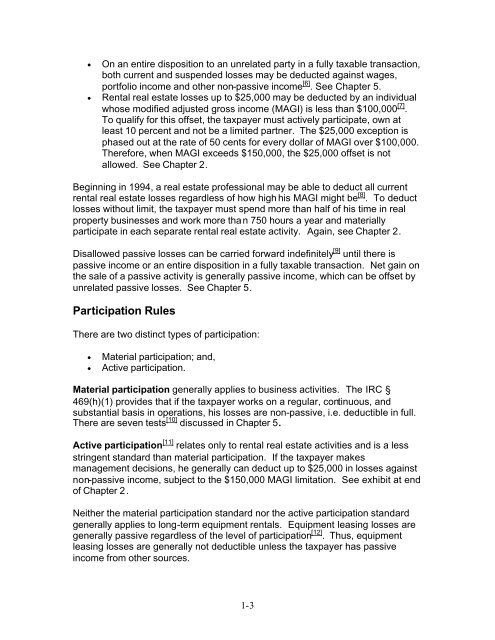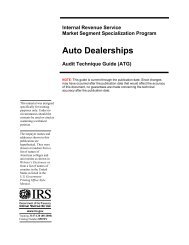Passive Activity Losses - Uncle Fed's Tax*Board
Passive Activity Losses - Uncle Fed's Tax*Board
Passive Activity Losses - Uncle Fed's Tax*Board
Create successful ePaper yourself
Turn your PDF publications into a flip-book with our unique Google optimized e-Paper software.
• On an entire disposition to an unrelated party in a fully taxable transaction,<br />
both current and suspended losses may be deducted against wages,<br />
portfolio income and other non-passive income [6] . See Chapter 5.<br />
• Rental real estate losses up to $25,000 may be deducted by an individual<br />
whose modified adjusted gross income (MAGI) is less than $100,000 [7] .<br />
To qualify for this offset, the taxpayer must actively participate, own at<br />
least 10 percent and not be a limited partner. The $25,000 exception is<br />
phased out at the rate of 50 cents for every dollar of MAGI over $100,000.<br />
Therefore, when MAGI exceeds $150,000, the $25,000 offset is not<br />
allowed. See Chapter 2.<br />
Beginning in 1994, a real estate professional may be able to deduct all current<br />
rental real estate losses regardless of how high his MAGI might be [8] . To deduct<br />
losses without limit, the taxpayer must spend more than half of his time in real<br />
property businesses and work more tha n 750 hours a year and materially<br />
participate in each separate rental real estate activity. Again, see Chapter 2.<br />
Disallowed passive losses can be carried forward indefinitely [9] until there is<br />
passive income or an entire disposition in a fully taxable transaction. Net gain on<br />
the sale of a passive activity is generally passive income, which can be offset by<br />
unrelated passive losses. See Chapter 5.<br />
Participation Rules<br />
There are two distinct types of participation:<br />
• Material participation; and,<br />
• Active participation.<br />
Material participation generally applies to business activities. The IRC §<br />
469(h)(1) provides that if the taxpayer works on a regular, continuous, and<br />
substantial basis in operations, his losses are non-passive, i.e. deductible in full.<br />
There are seven tests [10] discussed in Chapter 5.<br />
Active participation [11] relates only to rental real estate activities and is a less<br />
stringent standard than material participation. If the taxpayer makes<br />
management decisions, he generally can deduct up to $25,000 in losses against<br />
non-passive income, subject to the $150,000 MAGI limitation. See exhibit at end<br />
of Chapter 2 .<br />
Neither the material participation standard nor the active participation standard<br />
generally applies to long-term equipment rentals. Equipment leasing losses are<br />
generally passive regardless of the level of participation [12] . Thus, equipment<br />
leasing losses are generally not deductible unless the taxpayer has passive<br />
income from other sources.<br />
1-3

















